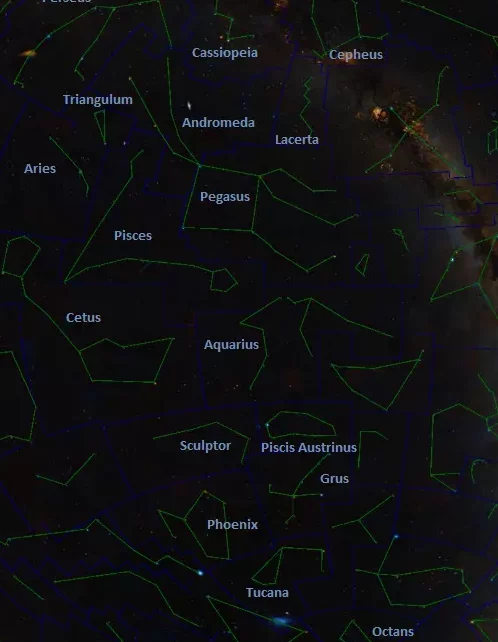All four seasons that we experience are incredibly magnificent, but autumn holds a special place in our hearts. A.S. Pushkin eloquently expressed his admiration for this season in his poem “Autumn”. One poetic line captures its essence perfectly: “I love the vibrant fading of nature…” This line encapsulates the beauty of the earthly realm during autumn.
All four seasons that we experience are incredibly magnificent, but autumn holds a special place in our hearts. A.S. Pushkin eloquently expressed his admiration for this season in his poem “Autumn”. One poetic line captures its essence perfectly: “I love the vibrant fading of nature…” This line encapsulates the earthly beauty that manifests during the fall season. But what celestial wonders can be observed in the vast sky above?
In the realm of Russian and global poetry, there exists a plethora of examples depicting the essence of autumn. However, for the purpose of our discussion on the celestial vault, we will focus on one particularly lyrical masterpiece that aptly captures the essence of the starry sky:
Within the original autumn
Lies a brief yet awe-inspiring season.
The entire day glistens like crystal,
And the evenings exude radiance….
These lines, penned by F. Tyutchev nearly two centuries ago, possess an astonishingly contemporary and relevant quality. Presently, we find ourselves at the onset of the enchanting Crimean autumn, a graceful velvety season that epitomizes the concept of “radiant evenings”. It is an opportune time to acquaint ourselves with the celestial luminaries. Autumn surprises and captivates us with its portrayal of the waning earthly nature, and when combined with the celestial splendor above, one can truly experience the zenith of bliss.
We would like to take this moment to remind our readers that our focus primarily lies on capturing the imagery of the evening starry sky, visible to the naked eye on a clear night shortly after sunset, when darkness abounds. As we slumber peacefully at night and resist awakening in the early morning, the evening hours prove to be the optimal time for stargazing, a pleasurable and enriching endeavor in every conceivable way. Let us commence this journey by exploring the most prominent stars and constellations.
The Star Triangle of Greatness
It is fascinating that in the vast expanse of the night sky, observers frequently observe peculiar combinations of stars that bear a resemblance to familiar objects, animals both real and mythical, as well as geometric shapes from our school days – squares, rhombuses, triangles, and even trapezoids. Today, we will examine the renowned Big Star Triangle.
Remarkably large in size, or rather, in terms of the area they occupy in the celestial sphere, there are two well-known star triangles: the Winter Triangle and the Autumn Triangle (referred to as the Summer Triangle during the summer months). These are not names of constellations, but rather arrangements, representations of bright stars that belong to different constellations and collectively form noticeable and expansive triangles.
The Winter Triangle is comprised of the first magnitude stars Sirius, Procyon, and Betelgeuse, while the Autumn Triangle consists of equally brilliant stars Vega, Deneb, and Altair, belonging to the constellations Lyra, Cygnus, and Aquila, respectively. Let us take a closer look at these remarkable celestial formations.
The Lyra constellation
Despite its relatively small size, Lyra is the most prominent constellation of the “autumn of the original”. It may be small, but it is also distant, and a quick glance is all it takes to see for yourself. Interestingly, finding the main star of this constellation, Vega, is a matter of seconds – just look up in the evening.
Vega, the brightest star in the northern hemisphere, shines almost directly above. In the southern celestial hemisphere, the equivalent star is Sirius, but here it is Vega.
If we can locate Vega, then finding the constellation Lyra requires little additional effort. Vega is a part of this constellation, and by looking at Vega, we can already see Lyra itself.
If you look closely near Vega, you will notice four less bright stars arranged in a pattern resembling a small parallelogram from a high school geometry course. Together with Vega, these few stars form the small yet noticeable constellation Lyra.
Lyra appears small in angular size – if you extend your arm in its direction, it will seem no bigger than your little finger. The ancient Greeks, who named this constellation, saw in the sky a resemblance to the ancient musical instrument Lyra.
On clear moonless nights, to the northeast of Vega, you can observe the unique double star epsilon Lyra. It is one of the few double stars that can be seen with the naked eye. Interestingly, even with a small telescope, it is apparent that each component of this cosmic pair is also a double star. Thus, the seemingly inconspicuous star Lyra epsilon is actually a system consisting of four giant-sized stars.
The Eagle constellation
Let’s carefully examine the illustration. It depicts three stars from three different constellations. We are already familiar with Vega and Deneb, and today we will locate Altair. It’s quite easy to do.
In the image, Altair is shown to the left and below, at the apex of a large isosceles triangle. By following the diagram, we can look up into the sky and find Altair almost exactly in the southern direction. To confirm, we can use the method of extending our arm to measure the distances. Both from Vega and from Deneb to Altair, the distance is approximately an inch and a half. This demonstrates how the ancient and forgotten unit of measurement using fingers can be utilized in the highly precise field of astronomy!
We have successfully located Altair, which is the principal star of the Eagle constellation. Now, what is this constellation all about? The most prominent feature of the constellation is Altair, accompanied by two stars nearby and a chain of stars diagonally descending to the right. Sometimes, this configuration is simply referred to as an “airplane,” as it is easy to remember and locate among the stars. By paying attention to two additional stars, one below and one above, we can understand why the ancient Arabs referred to this constellation as the Eagle.
Let’s summarize some of our findings. The notable constellations mentioned, Lyra and the Swan, are visible in the evenings during early fall, positioned very high in the sky, almost directly above us. The Eagle is slightly lower, located in the southern region of the sky. The brightest stars, Vega, Deneb, and Altair, which serve as the main stars of these constellations, form the Great Star Triangle. During the summer, this pattern is known as Summer, and during the fall, it is referred to as Autumn. When we hear either name, we will know it is referring to the same arrangement of stars. The next celestial object we will acquaint ourselves with is the colossal Hercules constellation, which is located to the right on the diagram and can be observed in the evening sky in the southern direction.
Wishing you clear skies and successful observations!
A. Kopylenko,
an astronomer,
In the picture: V. Nozhov, an amateur astronomer from Sevastopol (on the left), and the writer of the piece.
(The conclusion comes after this).

Constellations are well-known formations of stars that can be observed in the night sky. However, the visibility of these formations depends on the observer’s location and the time of year. In the northern hemisphere during the fall months, there are specific constellations that can be seen from Russia.
To easily navigate the fall sky, one can use the Pegasus Square asterism. This formation is made up of four bright stars, namely Sheat, Markab, Algenib, and Andromeda’s alpha Alpheratz, which are all part of the Pegasus constellation.
The celestial beauty of the night sky
The constellation of Andromeda, with its distinct shape resembling a split V, is renowned for being home to the magnificent object M31. Located within its constellation, M31 is the Andromeda galaxy, a stunning celestial entity that lies outside our own Milky Way, approximately 25,000 light-years away. What sets M31 apart is the remarkable fact that it can be observed with the naked eye, making it one of the few objects in the universe visible to us without the aid of any telescopic equipment.
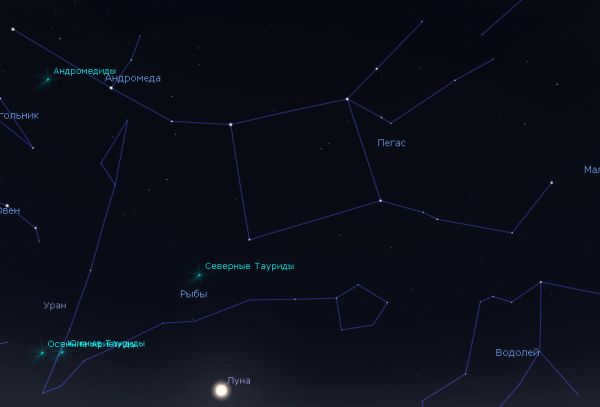
Asterism Pegasus Square
Most notable
Among the constellations visible in the autumn sky are four zodiacal constellations: Pisces, Taurus, Aries, and Capricorn. Capricorn is situated close to the horizon and its “arrow” points towards the intricate figure of Aquarius. To locate Pisces, the easiest way is to trace a line from the lower left corner of the Pegasus Square, which resembles a curved number 2 with a loop at the lower end. On the other hand, Taurus is found in the southern direction and appears like an inverted letter Y.
What other sights can be spotted during autumn
Additional constellations that can be observed in the autumn sky include the Whale and its neighboring Eridanus, the Eagle and Swan set against the backdrop of the Milky Way, Perseus and the Lizard, the small Triangle, the Arrow, the Dolphin, and the Lesser Horse. Hiding near the horizon is the Sculptor, along with the Southern Fish and its alpha Fomalhaut, which is the most brilliant luminary of the fall season.
Among the notable features of the autumn constellations are two stars of significance. The first is Mira, a binary star that has given its name to the class of stars known as “Mira variables”. In less than a year, it undergoes such dramatic changes in brightness that it can go from being completely invisible to an observer on Earth to becoming the brightest star in its constellation. The second star, the renowned Tau Ceti, is noteworthy for being the closest Sun-like object and is situated just 12 light-years away.
Certainly, observing all of the aforementioned stars is only possible in remote areas, at high elevations, and under ideal weather conditions. However, within the confines of a bustling city on a clear night, one can still witness the brilliance of these stars and even discern the outlines of some. Equipped with just a regular pair of binoculars, the constellations of the autumn sky can be observed more clearly. Best of luck with your stargazing endeavors!
We are all familiar with the constellations that adorn the night sky. However, these celestial objects are not always visible. The visibility of these objects depends on two factors: the observer’s location and the time of year. Let’s focus on the fall months in the northern hemisphere. So, which constellations can be seen in the Russian latitudes during autumn?
For easy orientation in the autumn sky, look for the asterism known as the Square Pegasus. This asterism is formed by four bright stars, which are part of the constellations Pegasus (Sheat, Markab, and Algenib) and Andromeda (Alferats).
"Stargazing" birds and animals
During this season, you can explore the constellations of the fall sky. It can be educational for children to learn about mythical characters like Perseus, Andromeda, and Cassiopeia. Additionally, there are fascinating “star” animals such as the mythical Pegasus, the curly-haired Aries, the small reptilian Lizard, and the sea creatures Whale and Fish.
The brightest constellations visible in the fall sky are Cassiopeia, Pisces, Pegasus, and Andromeda. These four constellations are particularly visible on clear nights during the autumn season.
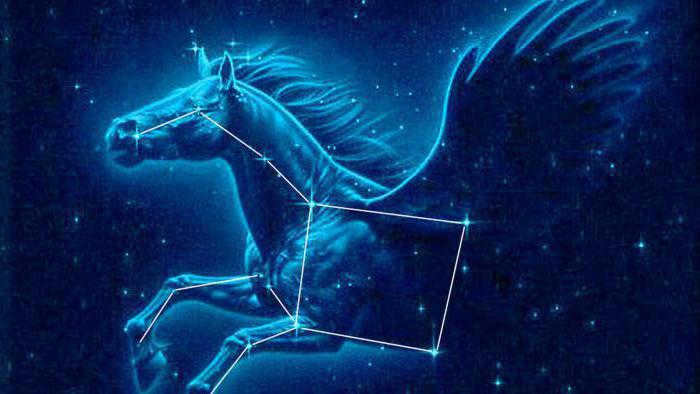
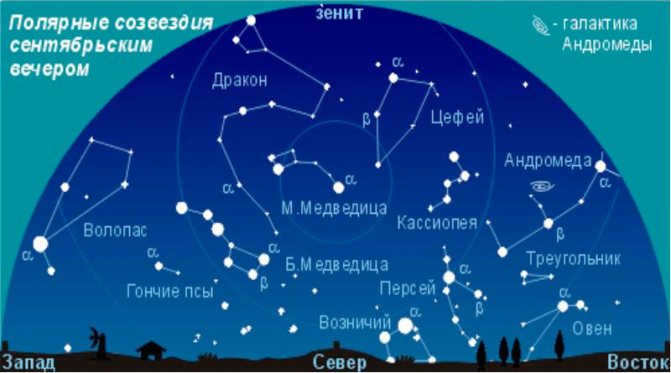
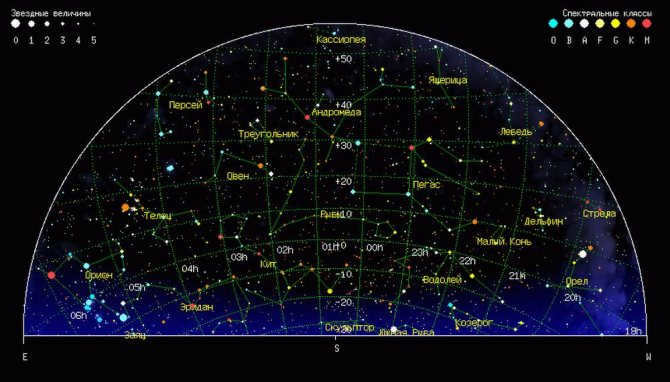
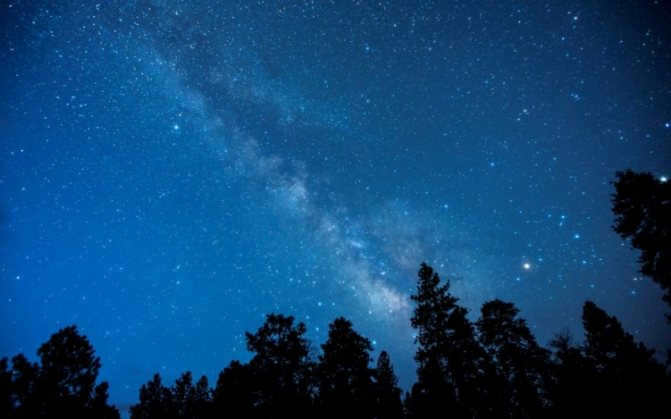
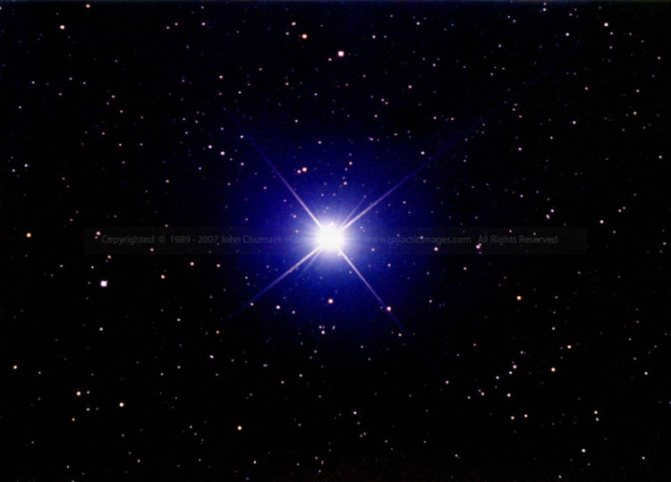
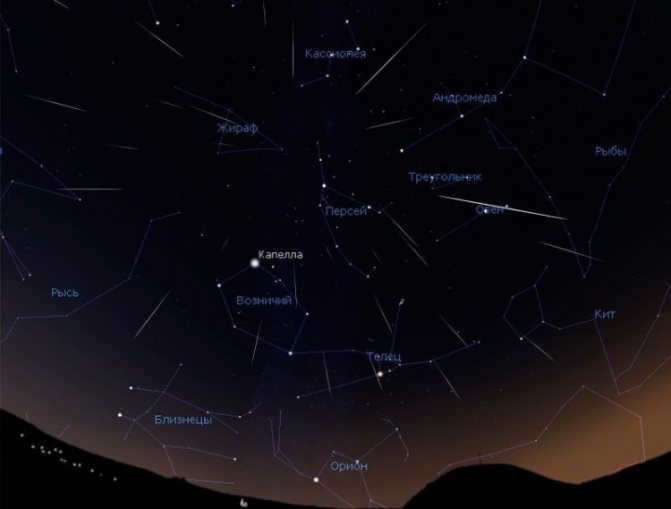
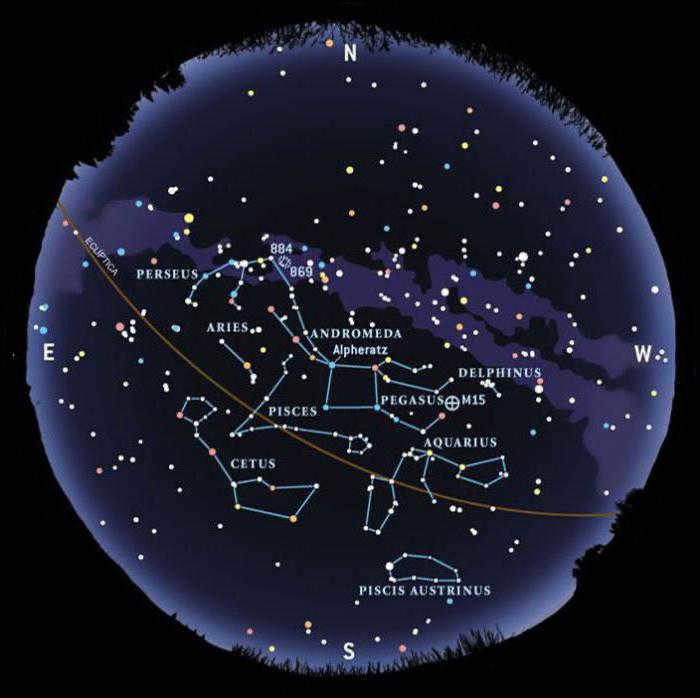
We have acquainted ourselves in a general way with the dazzling stars and constellations of the winter sky. One might wonder: which cities can benefit from this overview?
The answer is straightforward: virtually all cities, regions, and republics of Russia, as well as neighboring countries. The winter night sky in Siberia is essentially the same as in Crimea, St. Petersburg, Moscow, Almaty, Kiev, and Minsk. The only distinction lies in the latitude of the observation location. In the northern regions, you won’t be able to spot the Hare constellation, and in the Big Dog, Sirius will be the only visible star. Conversely, if you find yourself in the southern part of Russia, you’ll have the opportunity to peer “beyond the horizon” of those in the north and catch a glimpse of the Korma, Compass, and Dove constellations.
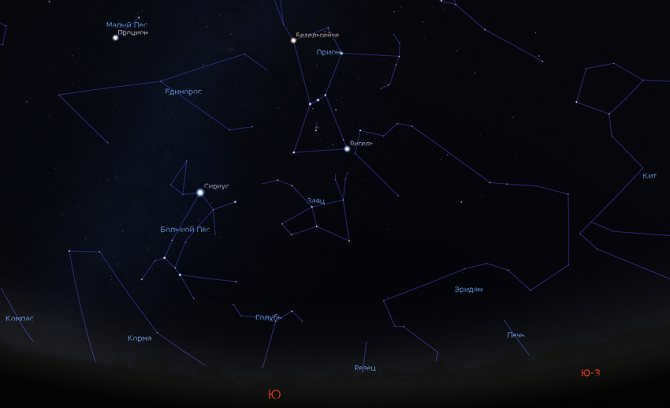
If the images displayed above depicted the celestial dome as observed in the central region of Russia, the picture featured here portrays the night sky over the Caucasus. It showcases a selection of constellations located to the south of Orion that remain unseen from Moscow: Sculptor, Pyxis, Fornax, and Columba. Image source: Stellarium
The most prominent constellations and stars in the autumn sky
Pegasus, which is one of the many celestial objects visible in the autumn sky, is particularly prominent during this time of year. This constellation, resembling a square, is composed of four of the brightest stars. It includes the Arabic named stars Sheat, Makrab, Algenib, and Alferats. Additionally, there is a trio of luminous stars that form a handle emerging from the upper left corner of the square. Two of these stars, Alamak and Mirah, also have their own names. Interestingly, the square and the handle together bear a resemblance to a miniature version of the Big Dipper found in the night sky. Furthermore, these “handle” stars are also part of the Andromeda constellation.
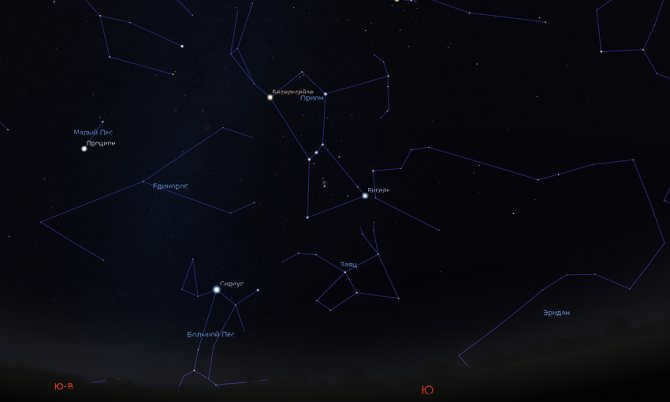
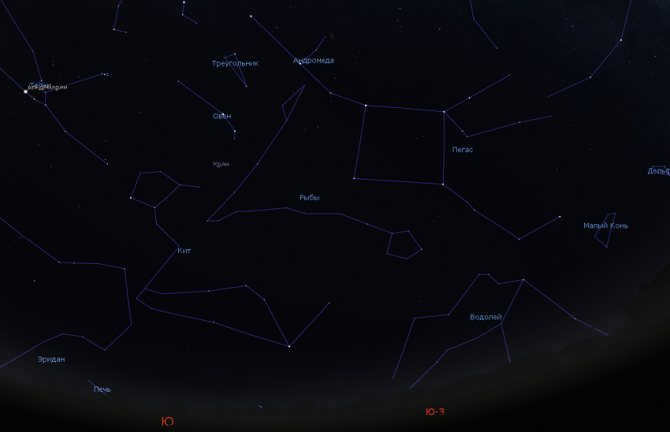
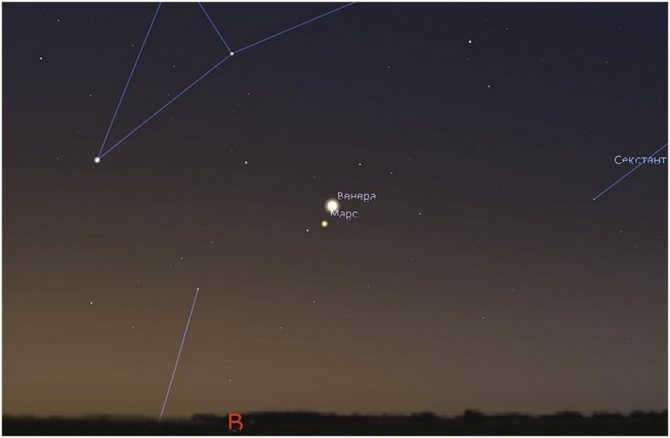
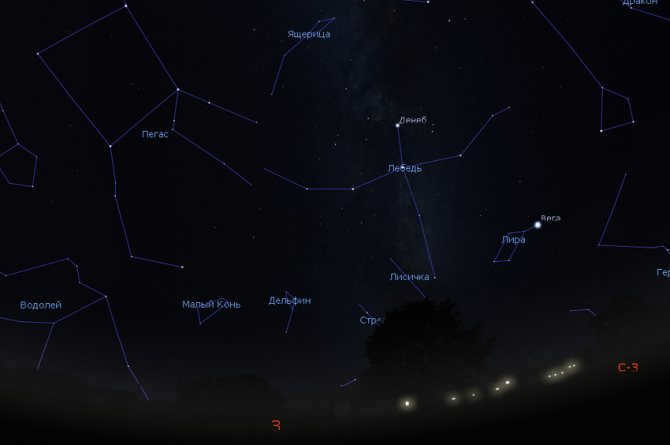
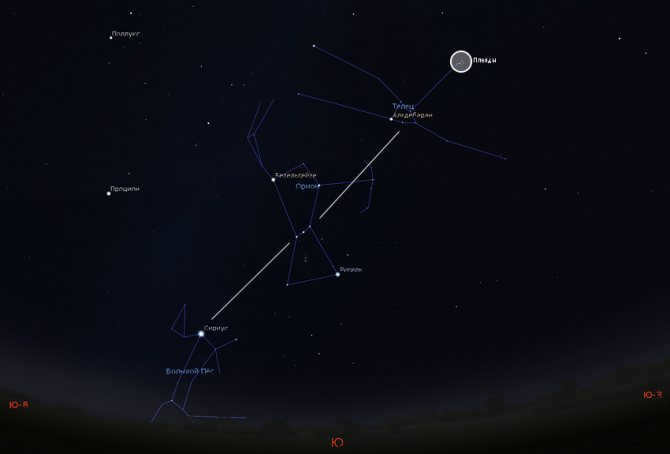
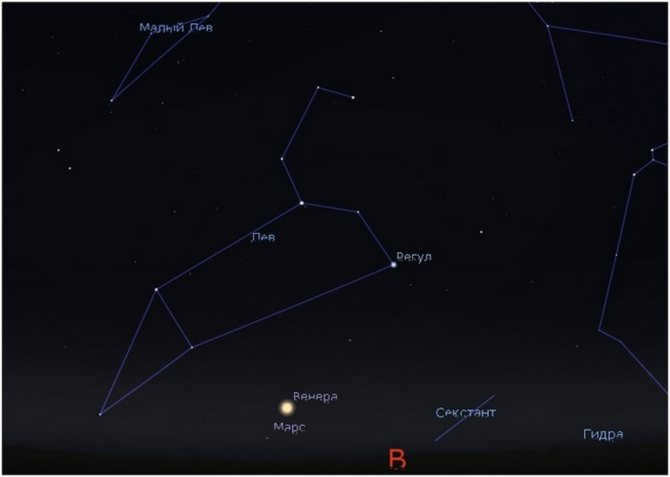
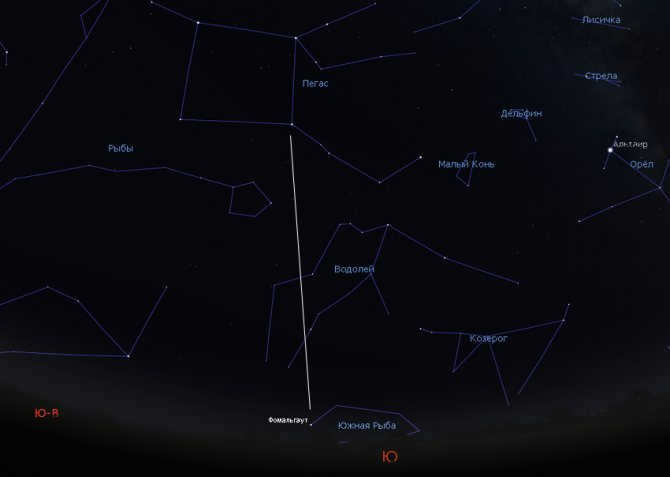
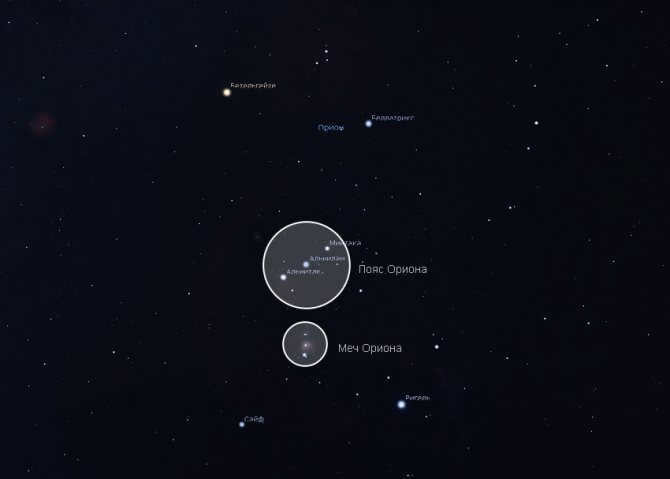
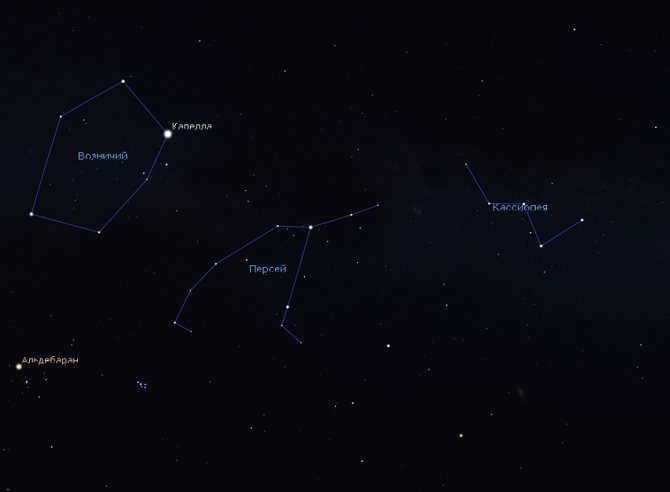
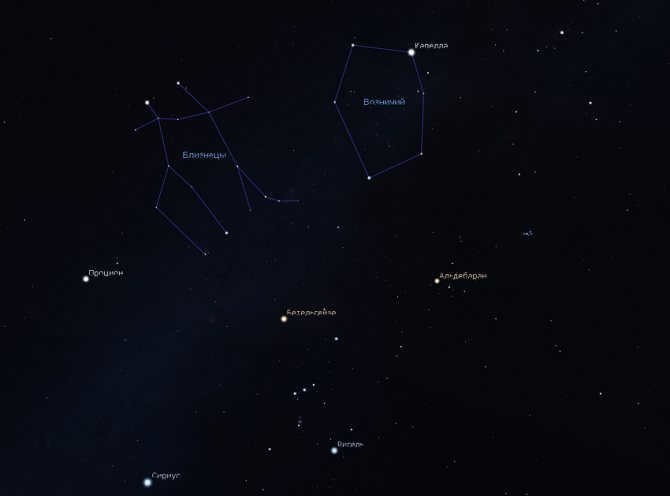
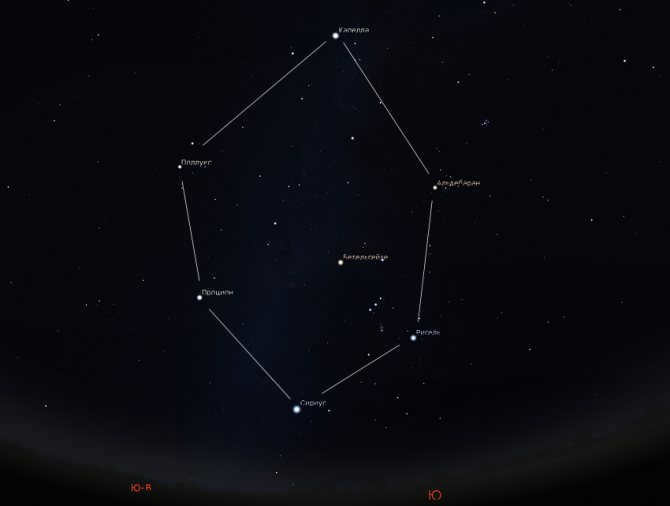
Pegasus and the closest galaxy
The constellation Pegasus is connected to the nearest galaxy, Andromeda, which has the shape of an inverted “A”.
November is the optimal time for observing Andromeda in the northern hemisphere. In the night sky, you can clearly see the group of stars that includes the closest galaxy, M 31.
M 31 belongs to the spiral type, similar to the Milky Way, and is located approximately 25,000 light years away from Earth. This galaxy can be seen with the naked eye as a bright spot on a clear night.
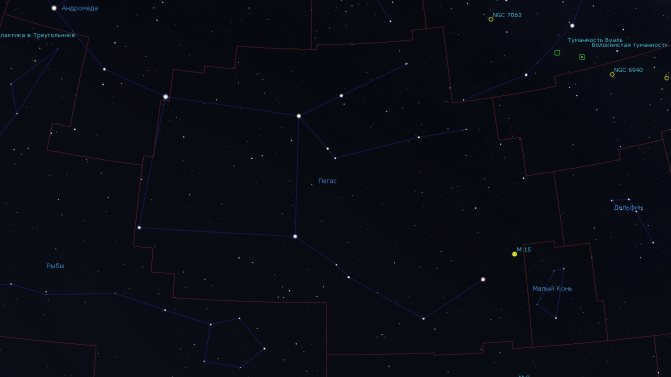
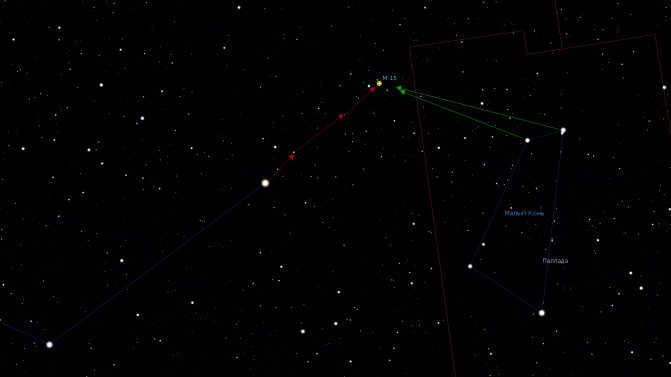
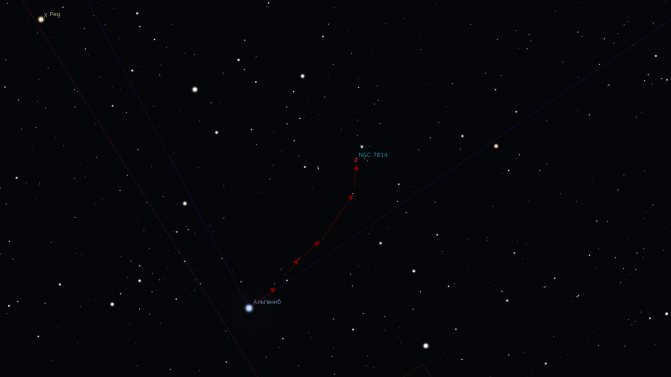
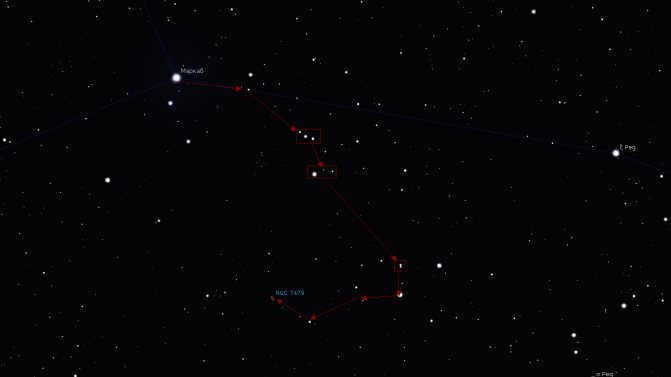
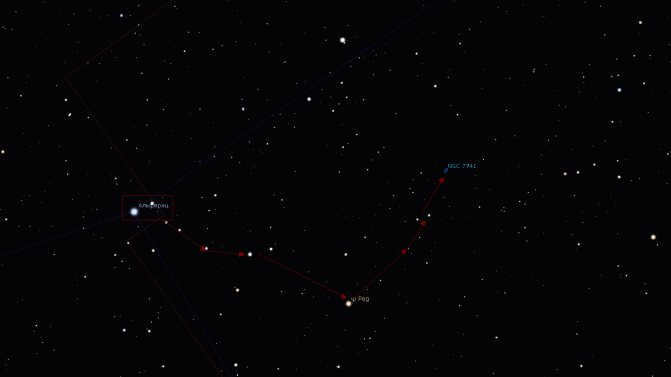
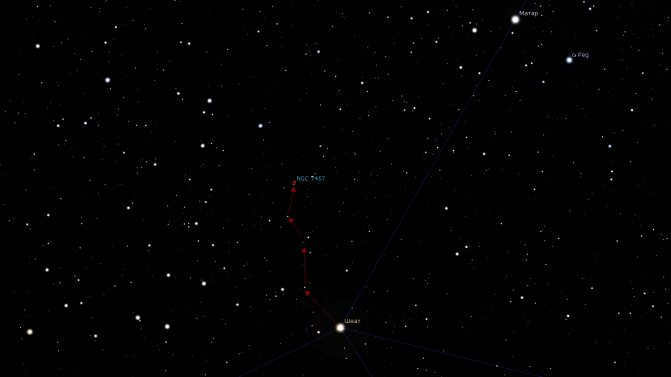
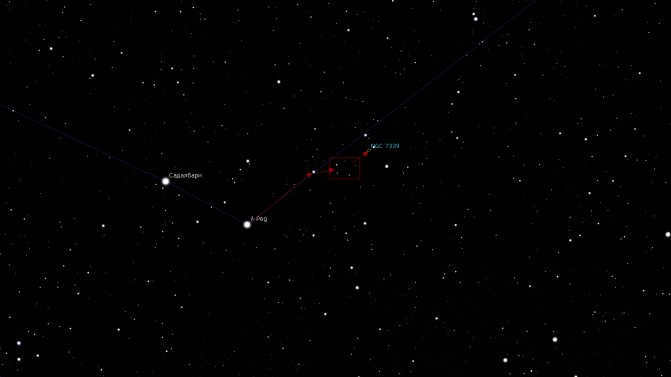
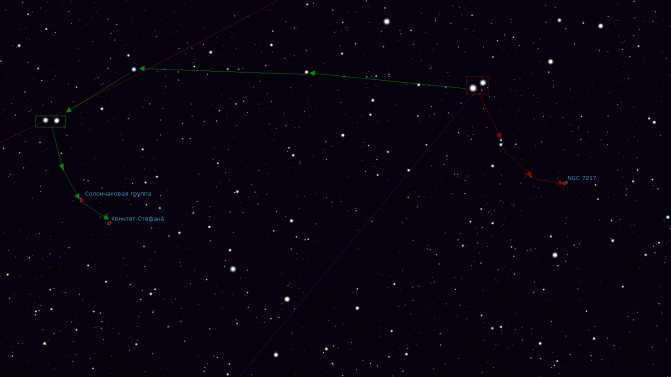
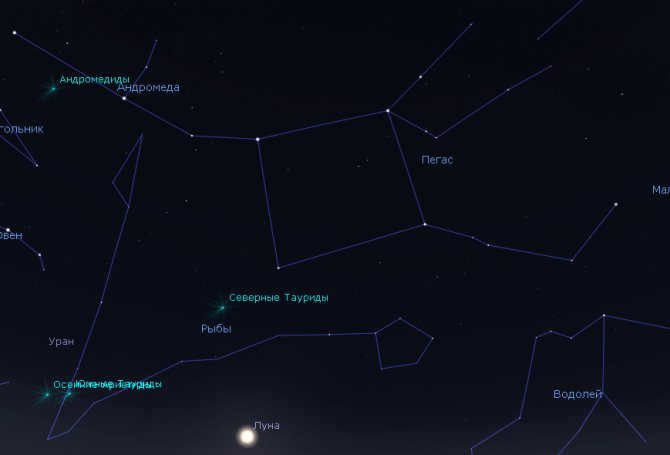
The southern hemisphere is home to a small constellation known as Sculptor. Covering an area of 464 square degrees, this constellation boasts up to 55 stars that can be seen without the aid of optics.
Sculptor is classified as a new constellation, having been identified by N. Lacaille in 1756.
Locating Sculptor in the night sky is relatively easy. Simply draw a line from the head of the Phoenix to Aquarius, and along this path, you will encounter the Sculptor constellation. However, residents of the southern regions of Russia are the only ones who can observe it.
Despite its dimness, with its Alpha star having a magnitude of only 4, the Sculptor constellation is notable for being the location of the South Pole of our Galaxy.
As part of Sculptor, there are several fascinating objects in deep space that can be observed. These include a dwarf galaxy shaped like an ellipse and a large spiral galaxy known as Silver Coin.
The Mysterious Disappearance of Pisces Constellation
The constellation Pisces is symbolized by a pair of fish, which are separated into a northern and western section but connected by a single point in their tails. Spotting the Pisces constellation can be a bit more challenging compared to Cassiopeia, due to the greater dispersion of stars in the night sky. It consists of a fainter group of stars in terms of brightness and has a shape resembling a “V”. Pisces is bordered by the square of Pegasus and the asterism of Aries.
These are just a few of the constellations visible in the autumn sky. There are numerous other beautiful and enigmatic objects to observe during this time of year.
No, it is not true! The relative arrangement of the stars in the celestial sphere has remained unchanged for millennia! If you happen to observe a luminous celestial body in the winter sky, it is most likely a planet!
The planets traverse the zodiacal constellations along the ecliptic. As a result, you can only locate them in the winter sky within the boundaries of the constellations Taurus or Gemini. (In the year 2020, Venus, the most brilliant planet visible from Earth, will pass through these constellations in the spring!)
Post Views: 2,521
Tags: Aldebaran, Betelgeuse, Gemini, starry sky, Capella, Orion, Pleiades, Pollux, Procyon, Rigel, Sirius, constellations, Taurus.
Aries, Perseus, and Lizard
Located in the southeastern part of the autumn sky, we can find a fascinating pair of celestial objects known as Aries and Perseus.
Just below the handle of Andromeda, we can easily spot two stars that go by the names Sheratan and Hamal. These stars are the most prominent features of Aries.
While the other stars in Aries are relatively faint and often go unnoticed, there is another constellation nearby called Perseus that contains the most brilliant star in this part of the sky – Mirfak, also known as its alpha star. Mirfak is not only the brightest star in Perseus but also the most luminous in the entire autumn sky. Additionally, Perseus is home to the captivating double cluster of Hee and Ash, which are among the most visually appealing clusters in the celestial sphere.
The Lizard is the smallest and least noticeable constellation in the autumn sky. It lacks prominent stars and consists of only five fourth-magnitude luminaries. Its shape is reminiscent of a “snake”. On its left side, it is bordered by the asterism Cassiopeia, while below it lie the constellations Pegasus and Andromeda.
Not only the constellations of the autumn sky, but also those of other seasons, are appealing to curious space explorers.
Chapter 7.
Constellations in the autumn night sky.
Among the remarkable constellations visible in the autumn night sky, one can easily spot the distinctive Perseus’ cirrus, the chain of bright stars in Andromeda, and, of course, the famous square formation of Pegasus. Just above them, there is a small chain of stars forming the Lizard constellation. Just below Andromeda, you can find the Triangle constellation, located directly below Aries, and right below the vast Whale constellation. Situated just below the winged horse are the two remaining constellations we will discuss in this article – the dim yet expansive Pisces and Aquarius constellations. It’s worth noting that when searching for Pisces and Aquarius, you should look not from the square of Pegasus itself but from another prominent star in this constellation – epsilon of Pegasus. Here is an overview map of the constellations visible in the autumn night sky, which we will be exploring further.
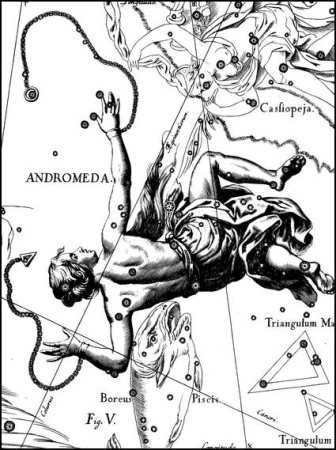
Right below Andromeda lies a small constellation characterized by a dim arrangement of stars –
The Triangle.
The Triangle covers a mere 132 square degrees in the sky and consists of only 15 stars that can be seen with the naked eye. However, it also houses one of the most radiant galaxies in our sky – M33. This galaxy’s luminosity is right at the threshold of visibility for the human eye, so locating it without any optical instruments requires an extremely dark and clear sky. Moving even further down, below the Triangle, we come across
Aries.
It is not particularly large, spanning 441 degrees, but it contains 40 stars with magnitudes up to the sixth. Aries presents some captivating binary systems and a couple of galaxies that can already be observed using average instruments. The Uranograph atlas depicts the constellation in the following manner –
Just below Aries lies the constellation The whale
Keith is an expansive constellation, covering 1230 square degrees, and it boasts around a hundred stars that can be seen without the aid of a telescope. Within Keith is the well-known long-period variable star omicron Keith-Mir, which has given its name to a class of variable stars known as mirids. Additionally, Keith is home to various other variable and double stars, as well as a couple of galaxies that can be observed with small telescopes. Hevelius has depicted Keith in the following manner –
To the west of Andromeda, we come across the prominent square formation of the constellation Pegasus
Pegasus features a notable globular star cluster among its nebular objects, along with a few galaxies that can be observed using small amateur telescopes, as well as a handful of intriguing double stars. In terms of size, Pegasus is a substantial constellation, covering an area of 1121 square degrees. It contains around a hundred stars that can be seen with the naked eye.
Just north of Pegasus, there is a small group of faint stars that form the Lizard constellation.
This constellation is one of the smaller ones in the sky, spanning 201 degrees. There are 35 stars in the Lizard that can be seen with the naked eye. It contains a few dim double stars and a scattered star cluster. Right below Pegasus, you can find the constellation of Pisces.
Pisces
. It is a relatively large constellation, covering an area of 889 square degrees. There are 75 stars brighter than the sixth magnitude in Pisces. This constellation also has some interesting double stars, a couple of small galaxies that can be observed with small telescopes, and it is also the location of the vernal equinox. Here is how Hevelius depicted Pisces –
Lastly, the constellation of Aquarius is located even lower than Pisces and Pegasus, completing our journey through the fall sky.
Aquarius encompasses a total of 90 stars that are visible to the naked eye, making it quite a large constellation with an area of 980 degrees. This constellation offers a wide range of objects that can be observed using amateur instruments, including a couple of bright globular clusters, a couple of nebulae, and a few interesting double stars. Additionally, Aquarius is home to three relatively bright meteor streams. With this, we conclude our general overview of constellations visible in the sky from mid-latitudes in the northern hemisphere. Each individual constellation will be explored in a dedicated series of posts, which can be accessed through the table of contents along with other helpful information for beginners.
Constellations of the autumn sky
The idea is subject to conditions and will be showcased here through a stunning view of the celestial sky
October 01 at 22:00
in the Russian Federation. Apart from the constellations associated with the “autumn” season, one can also observe the constellations typically seen during summer in the evening, those associated with winter during the night, and those linked to spring closer to morning.
Phoenix
Phoenix is a small constellation located in the southern hemisphere. It spans an area of 469 square degrees, making it easily distinguishable with nearly 70 stars.
The shape of Phoenix resembles that of a bird, with the elongated pentagon representing its body and the two broken lines as its wings. This constellation is fully visible in the southern hemisphere, while in the northern hemisphere, it can only be observed south of the 32nd parallel.
To locate Phoenix in the night sky, you can draw an imaginary line connecting the two brightest stars in this region: Ahernar from the constellation Eridanus and Fomalgaut from South Pisces. In between these stars, you will find another bright star known as Anka, which serves as the Alpha star of Phoenix.
Constellations listed for the autumn sky
| Russian name | Latin name (nominative) | Latin name (genitive) | Abbreviation | Area (square degrees) | Number of stars up to magnitude 6 |
| Andromeda | Andromedae | And | 722 | 100 | |
| Pegasus | Pegasi | Peg | 1121 | 100 | |
| Perseus | Persei | Per | 615 | 90 | |
| Aries | Arietis | Ari | 441 | 50 | |
| Triangulum | Trianguli | Tri | 132 | 15 | |
| Pisces | Piscium | Psc | 889 | 75 | |
| Cetus | Ceti | Cet | 1231 | 100 | |
| Lacerta | Lacertae | Lac | 201 | 35 |
Multiple star systems
10.1 The double star Matar (η Peg)
η Peg is a stunning double star system with two stars of different magnitudes, 2.9 and 9.3. These two stars are separated by a distance of 90.4″. The gap between them is easily observable even with amateur or semi-professional telescopes.
10.2 Double star λ Peg
λ Peg is a binary star system comprising a giant star of spectral class F with a brightness of 4.1m and a companion, a dwarf star with a magnitude of 9. The separation between the two stars is slightly more than 1″.
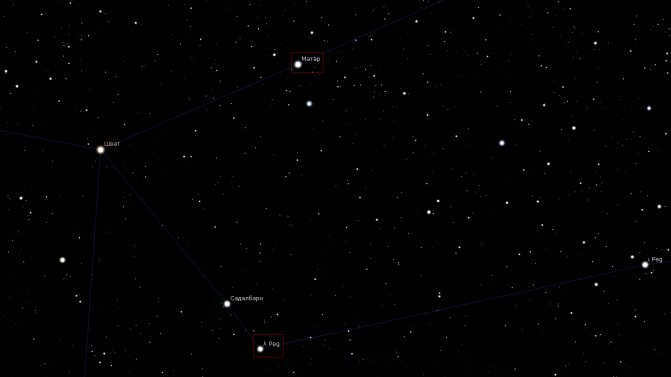
Do you not feel fatigued? Now, you possess the knowledge of the specific location to observe an abundance of galaxies, each with their own unique characteristics, within the Pegasus constellation. Direct your attention towards NGC 7331, a galaxy that eluded Charles Messier during his era. Additionally, remember to acknowledge the presence of the globular cluster M 15.

Watch this video to discover the constellations, prominent stars, planets, and deep space objects that are visible in the autumn night sky.
You will be able to spot well-known constellations such as the Big and Little Dippers, as well as the Spring-Summer-Fall Triangle formed by Vega, Deneb, and Altair. The Swan and the Milky Way, Pegasus and Andromeda, the Andromeda Nebula (M31), Taurus, Perseus, and Cassiopeia are some other fascinating features that can be observed. Moreover, make sure to look out for the Ascendant, Gemini, and the majestic Orion constellation.

14.9K messages 45.3K subscribers
Guidelines for the Community
What guidelines can we have here, except for the guidelines set by the peekaboo itself 🙂
So that’s who is blinding airplane pilots with lasers!)))) Got you, troublemaker)))
and what kind of camera with such a high sensitivity was used to capture the story ?
Wow! Where can we find such a sky within 150-200 km of Moscow.

The planet Saturn will be visible on August 18, 2023, at 00:01 PM.
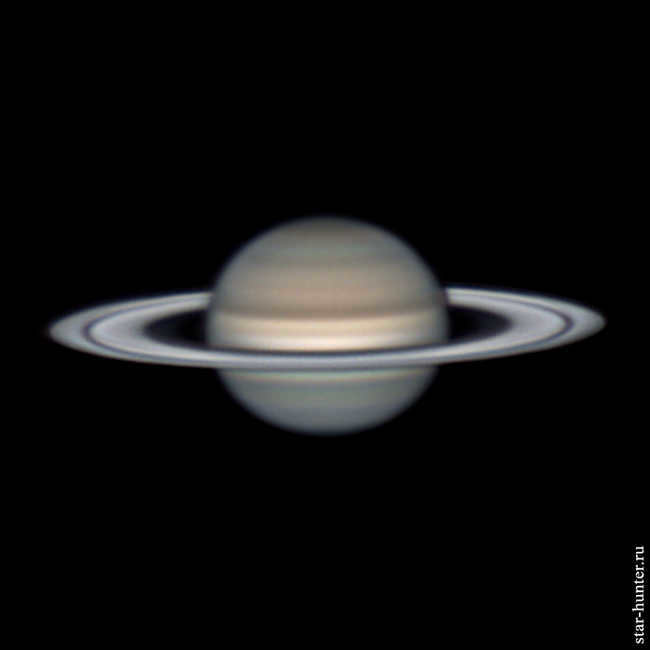
The following equipment was used for capturing this image:
-Sky-Watcher Dob 14 (350/1600) Retractable SynScan GOTO telescope
-Lensblock Barlow NPZ PAG 3-5x
-atmospheric dispersion corrector ZWO ADC
-ZWO IR-cut light filter
-astronomical camera ZWO ASI 183MC.
This mesmerizing image was taken at the Caucasus Mountain Observatory, Moscow State University, in the Karachay-Cherkess Republic.
Here is a small excerpt from the original video:

The Jellyfish Nebula captured in a sequence of three narrow-band filters
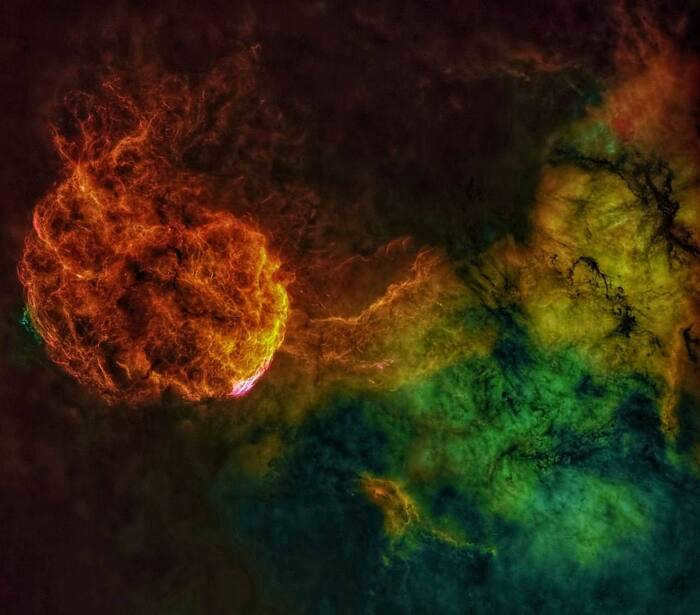

Comet C/2023 P1 (Nishimura): A Fresh Celestial Visitor
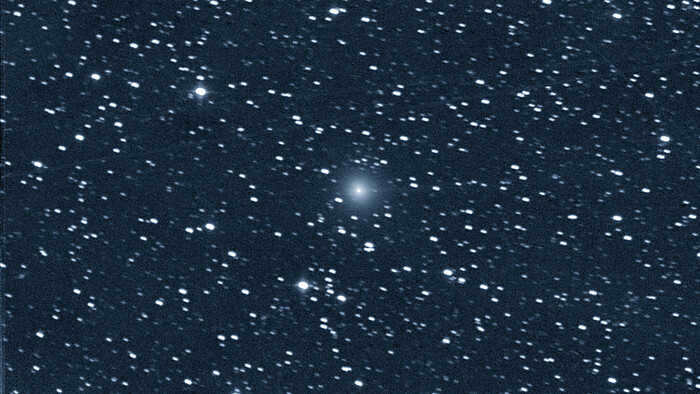
Comets are unexpected visitors. While the well-known ones can sometimes be disappointingly lackluster (which is understandable, as they have had time to deplete and disintegrate from repeated encounters with the Sun), newly discovered comets are often dazzling and captivating. However, this is not always the case.
Comet C/2023 P1 was detected by Japanese astronomer Hideo Nishimura on the night of August 11-12, 2023, in the Gemini constellation, where it still resides. It can be said that the comet’s discovery was a stroke of luck, as finding a faint, hazy object (with a magnitude of 12) in the brightening pre-dawn sky is a testament to exceptional luck and utmost professionalism.
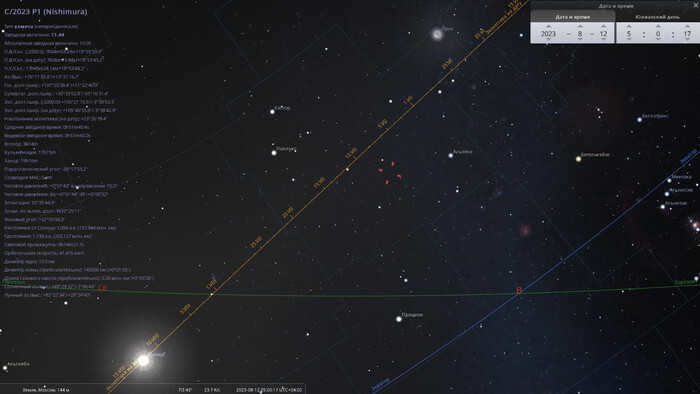
On the morning of August 12, 2023, the comet C/2023 P1 was located in the constellation Gemini (at the time of its discovery).
However, the comet has been increasing in brightness each night. After a week, it has already become visible to the naked eye as it has reached a magnitude of 10. It can now be observed using medium-power amateur telescopes. Although the comet is still best seen before dawn, its viewing conditions have slightly improved since it was first discovered.
What Comes After?
By September 18, 2023, the comet will reach perihelion, the point in its orbit closest to the Sun, at a distance of 33 million kilometers from its luminous surface. This is roughly twice as close as Mercury, although Mercury is a solid object while the comet is composed of ice. Due to its icy composition, the comet will begin actively melting and vaporizing well before it reaches perihelion. In fact, this process is already underway, and astronomers have observed a small tail, measuring only 8-10 angular minutes in length. This tail consists of gases and dust emitted from the comet’s heated nucleus.
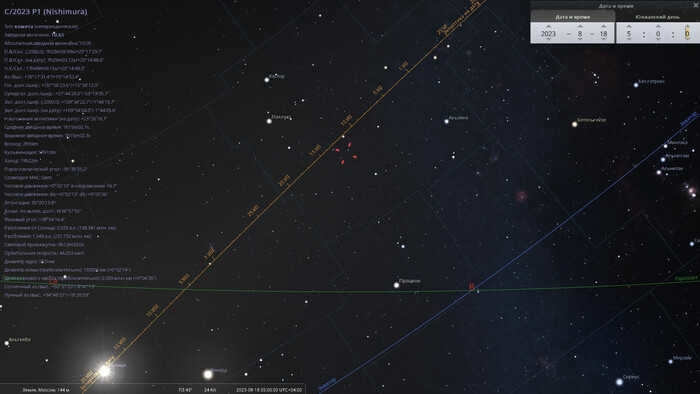
The location of comet C/2023 P1 in the constellation Gemini on the morning of August 18, 2023
Currently, the comet is crossing the Earth’s orbit and is positioned on the opposite side of the Sun. As a result, the distance between the Earth and the comet is quite significant, measuring one and a half astronomical units. However, this distance is rapidly changing.
By early September, the Earth will be much closer to the comet, with the distance reduced to one astronomical unit (and the comet will be only half an astronomical unit away from the Sun). While the angular distance from the Sun (elongation) will decrease slightly from 35 to 30 degrees, the increasing difference in declination between the Sun and the comet will compensate for this. In fact, the comet’s tail will be visible directly above the Sun, allowing for excellent viewing opportunities before sunrise.
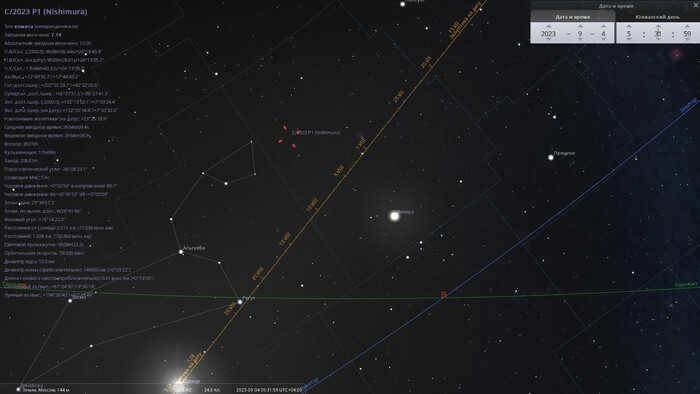
On the morning of September 4, 2023, comet C/2023 P1 will be positioned in the Cancer constellation
Comet C/2023 P1 Nishimura will be located in the Cancer constellation in the sky, near the border with the Leo constellation (look for the “Lion’s Head” asterism as a great reference point). In the same constellation, bright Venus will also be shining nearby. By September 4, 2023, the comet will reach a brightness of 7th magnitude, making it an easily observable object with binoculars.
Comet C/2023 P1 will come within 1 degree (west) of the star Adhafera (Zeta Leo) on the morning of September 9, 2023. At this time, the comet’s brightness will reach a magnitude of 6th, making it visible to the naked eye in areas with optimal viewing conditions such as mountains, deserts, and steppes.
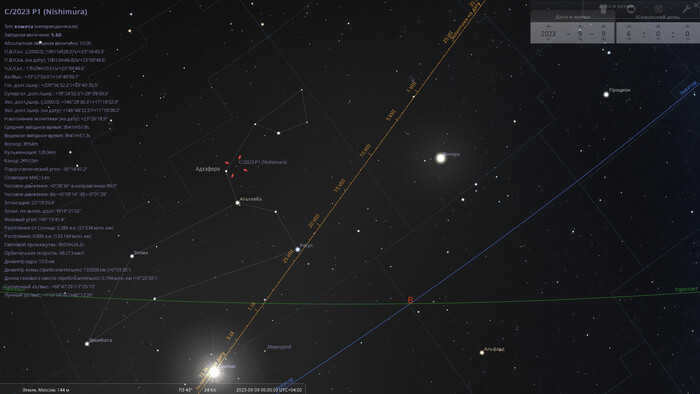

On September 9, 2023, the comet C/2023 P1 can be found in the constellation Leo.
Unfortunately, the distance from the Sun will decrease to 22 degrees, but the comet will continue to rise above the ecliptic. Even with such a small elongation, it will still be visible for at least one and a half to two hours.
In the coming days, the brightness of the comet will increase, but the distance from the Sun will decrease, making it more challenging to observe.
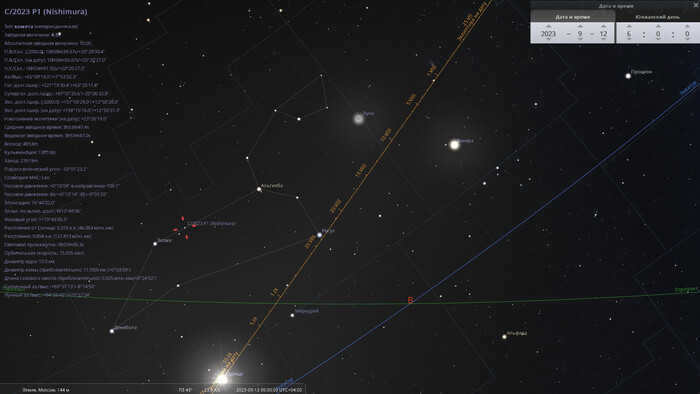
The position of comet C/2023 P1 in the constellation Leo on September 12, 2023, morning
During the morning of September 15, the comet will be in close proximity to the second magnitude star Denebola (Beta Leo). At this time, the comet will have a slightly lower brightness of about 3rd stellar magnitude. However, observing both celestial bodies will be challenging due to the relatively bright dawn sky.
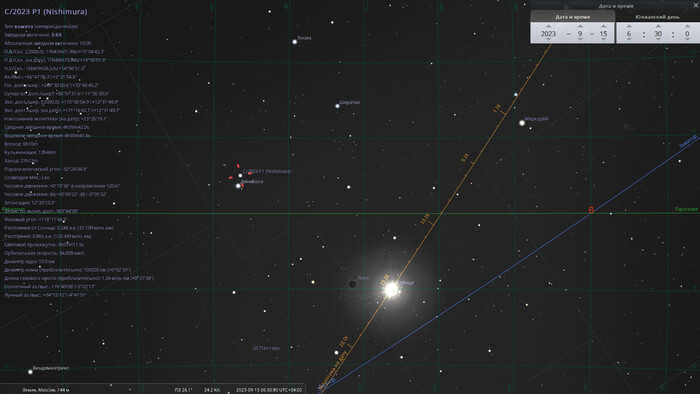
On September 15, 2023, in the constellation Leo, you can find the comet C/2023 P1 in the morning sky.
During perihelion, the comet is expected to have a brightness of about 2nd magnitude. In the evening, shortly after dusk, observers in the northern hemisphere will be able to see the comet in the northern part of the constellation Virgo. However, in the southern hemisphere, it will be challenging to observe the comet due to its higher declination compared to the Sun.

On the evening of September 18, 2023 (as it reaches perihelion), comet C/2023 P1 can be found in the Virgo constellation.
As time goes by, the comet will gradually move towards the southern celestial hemisphere and will cross the equator around the same time as the Sun, just a day before the autumnal equinox on September 21, 2023. The comet’s brightness will also decrease to 4.5m.
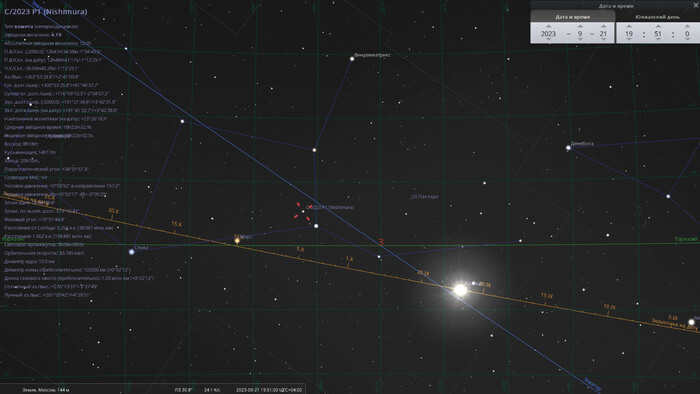
On the evening of September 21, 2023, you can locate comet C/2023 P1 in the constellation Virgo.
Comet C/2023 P1 Nishimura can be observed on the evening of October 1, 40 minutes after sunset, at the border of Virgo and Raven constellations. However, to witness this event, you will need to be in Australia or the middle latitudes of South America, or perhaps at the southern tip of Africa. The comet’s brightness will only be about 7.5m, so it may not be worth traveling just for this experience.
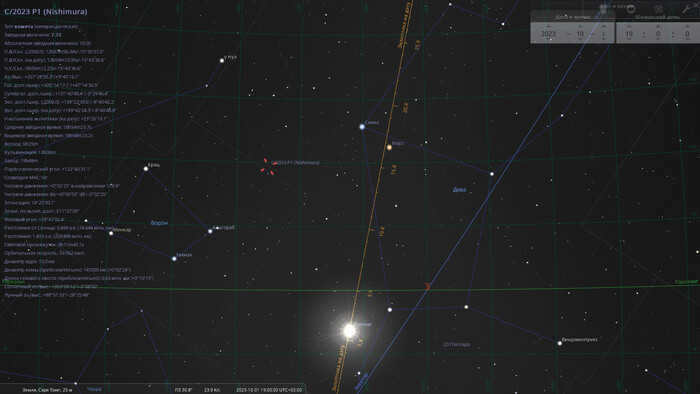
The location of comet C/2023 P1 on the evening of October 1, 2023, will be on the border of the constellations Virgo and Corvus (for an observer situated in Cape Town, South Africa).
By the middle of October, the comet will continue its journey further south – it will be positioned in the tail region of the constellation Hydra, and its brightness will decrease to the 10th magnitude. As a result, visibility conditions, even in the southern hemisphere, will become unsatisfactory. In fact, at this point, the comet will no longer be visible to astronomy enthusiasts around the world.
When will the comet come back?
Not on our watch. Currently, we only have approximate data on the comet’s orbital elements. These estimations are sufficient to calculate the comet’s position in the sky for the next few months. However, we do not know the exact period of its orbit. Despite being classified as a long-period comet, its eccentricity is believed to be one, indicating that its orbit is nearly parabolic or even such that it may never return to the Sun, or if it does, it could take millions of years.
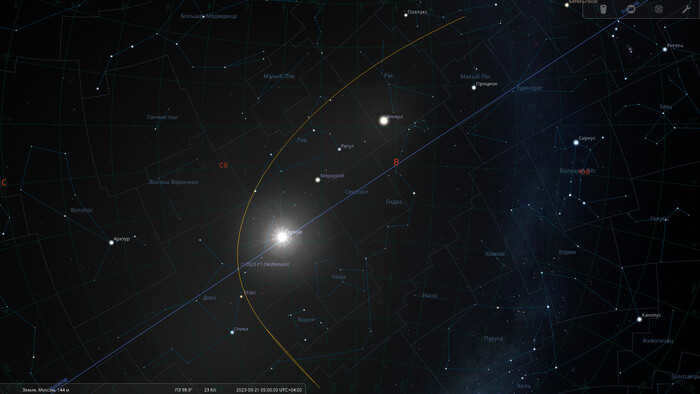
The path of comet C/2023 P1 Nishimura during the time period of August 12 to November 1, 2023.
All visual representations have been generated using the Stellarium software.
The most desirable locations in the solar system
The Soviet Union launched the first artificial satellite in 1957, marking the beginning of a new era in space exploration. Since then, numerous space agencies, private companies, and research institutes have been expanding their presence in the solar system. While there is seemingly infinite space available, certain areas are more coveted than others. One such example is the Lagrange points, which have attracted the attention of many. These points, named after the 18th-century mathematician who discovered them, offer a unique and stable location in our ever-changing cosmos.
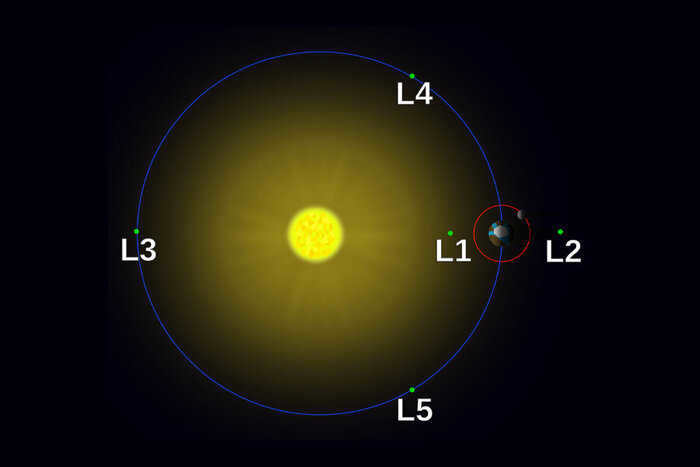
All celestial bodies have an effect on each other through gravity. This effect is particularly strong on objects that are close to each other. In these systems, there are also other forces at play that determine the shape of the orbits of the objects in motion. At the Lagrangian points, these forces are in balance. Therefore, if a small object is placed there, it will remain at a constant distance from the larger bodies, creating stable areas. These areas are often referred to as cosmic parking lots because once an object is in them, it requires very little energy to stay there. This makes them an ideal location for any man-made object that needs to remain in space for a long period of time.
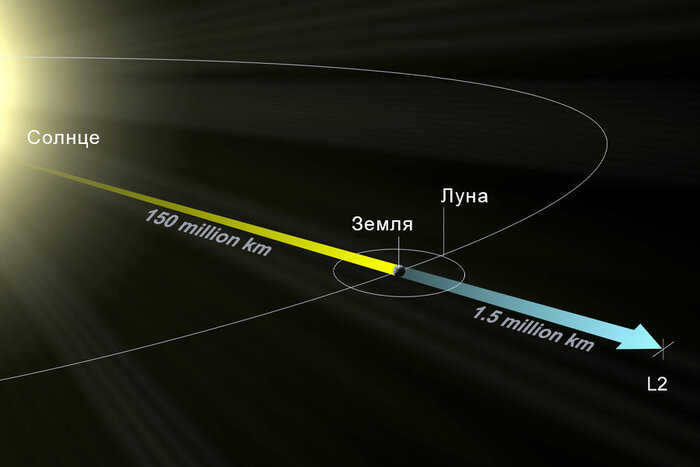
The issue of what precisely can be positioned in a specific Lagrange point is rather intriguing here. Let’s examine those formed by the gravitational interaction between the Sun and the Earth. L1 is situated between the two aforementioned celestial bodies approximately 1.5 million kilometers from our planet. Because the perspective of the star is never obstructed, it is an optimal location for observing the Sun.
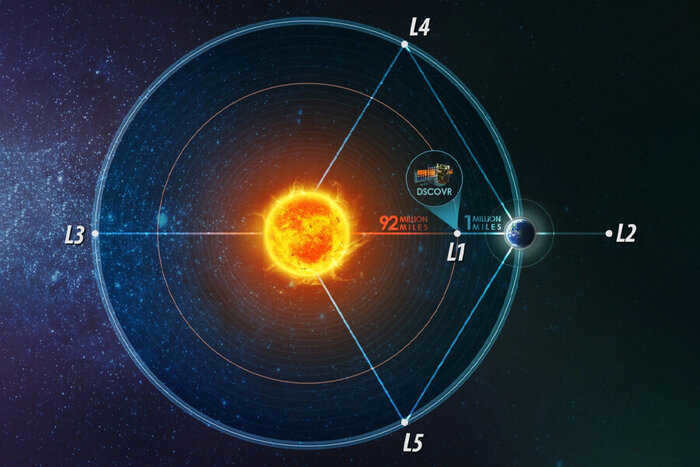
The Deep Space Climate Observatory is a spacecraft from the United States that is used to observe the Sun and Earth. It is located at Lagrangian point 1.
L2 is situated on the opposite side of the Earth, at the same distance. This position ensures that it remains shielded from direct sunlight and provides exceptional opportunities for observing the cosmos from a different perspective. In 2022, the James Webb telescope, a long-awaited project that astronomers have been anticipating for two decades, began its operations at this location.
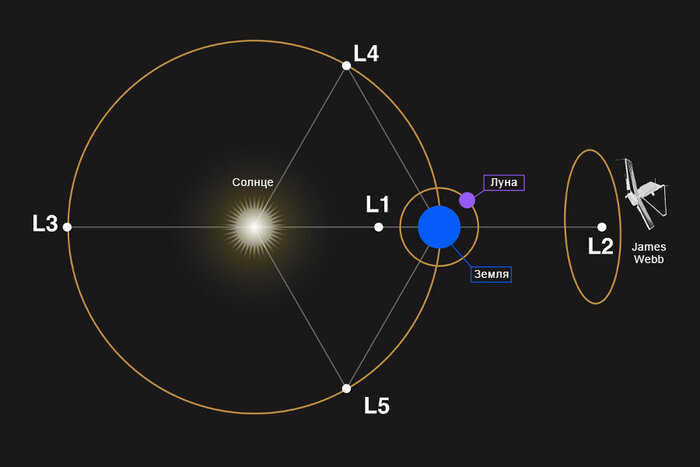
L3, located in the most enigmatic region on the opposite side of Earth’s path around the Sun, holds a unique position. It is the sole point in the vast expanse of the cosmos that remains beyond our planet’s observational reach, even in theory. Naturally, this intriguing fact has captured the imaginations of many science fiction authors, although scientists themselves find little practical value in this enigmatic spot.
L4 and L5 exhibit a slight variation compared to their predecessors. The key distinction lies in the fact that the initial three Lagrangian points in each set possess a subtle instability, causing objects within them to gradually shift position. While it is possible to maintain their presence in these points, it requires additional effort. The stability of L4 and L5 may not be particularly high in other pairs of celestial bodies, especially if their masses differ by less than a factor of 25. However, in the case of the Sun-Earth system, where the star is significantly more massive than the planet, these points demonstrate remarkable stability. Additionally, they appear to attract various objects, with the most striking example being L4 and L5 in the Sun-Jupiter system, which have accumulated thousands of asteroids.
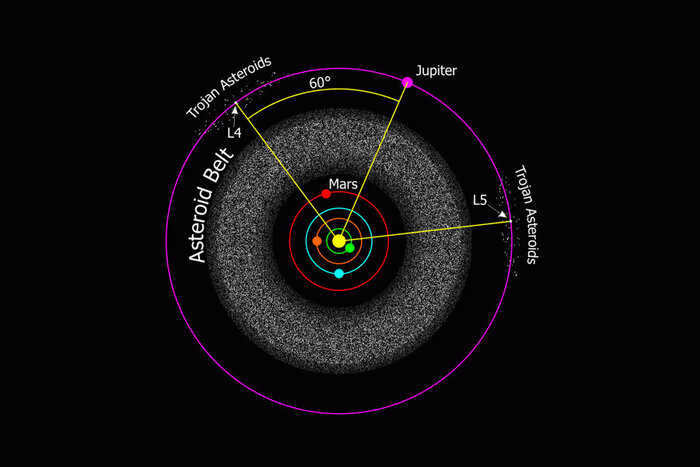
Every Lagrangian point in the solar system possesses its own unique characteristics. Some of these points could be suitable for gathering construction materials, if we consider drifting asteroids as such. Others could serve as locations for refueling stations to replenish fuel for spacecrafts traveling through deep space. It is also possible that human colonies could be “suspended” in these points. Of course, this is a matter of the distant future, a future that we might not live to witness, given the current events taking place on Earth. But it is always good to dream, isn’t it?
We appreciate your attention! If you found this article enjoyable, you can show your support by giving it a “thumbs up” or subscribing to this channel. We would also like to mention that we have our own Telegram channel where we regularly publish fascinating posts about space and astronomy.

